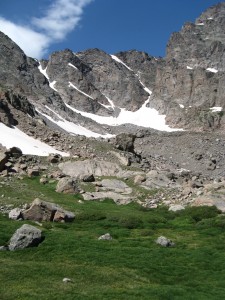14 December 2010
Microbes could influence nitrogen cycle in an alpine meadow
Posted by mohi
Alpine meadows surrounded by snow-capped mountains remind me of idyllic images from The Sound of Music. When I see photos of these meadows, I have to turn down the Julie Andrews soundtrack playing in my head and resist the urge to spin around, arms outstretched.
Photos of one such meadow in Colorado’s Rocky Mountain National Park drew me to poster #495 in the B13C “Cryospheric Biogeochemistry I” poster session. The environment appears balanced in the pictures, but the data shows that one of its nutrient cycles is out of whack.
The flow of nitrogen through the watershed as nitrate exceeds the amount brought in by snow and rain from air pollution. And this flow comes in pulses–including one in late summer long after the snowmelt has released its store of nitrogen compounds. This imbalance, coupled with pulsing flow, spells disaster for organisms in the region.
Where is the extra nitrogen coming from? Brooke Osborne from Colorado State University looked to the ground to solve the puzzle.
Studying the microbes in soil collected near Loch Vale, she found bacteria that transform nitrogen compounds from the air and snow into nitrate, which dissolves in water. Rain and runoff carries this new compound to the lake.
Loch Vale is adapted to low-nutrient conditions. When these nitrogen compounds run into the lake, it’s essentially raining fertilizer, Osborne says. Simple organisms like algae flourish. As they multiply, they consume oxygen in the lake, suffocating many larger animals.
Climate change could negatively impact the health of this lake: Increasing temperatures could increase microbial activity, Osborne says. Thus, busy bugs could make more harmful fertilizer that would eventually drain into the lake.
As a result, microbes may play a key role in the success of this ecosystem, and may ultimately influence the health of animals such as elk, marmots, and pika, which live in this high-altitude, low-nutrient land. Unfortunately, little is known about the communities that inhabit alpine areas because researchers assumed that these regions were too inhospitable for microbial life. Not so, says Osborne. “It may be an extreme environment, but there’s more life than you think.”
–Melissae Fellet is science communication graduate student at UC Santa Cruz



 GeoSpace is a blog on Earth and space science, managed by AGU’s Public Information staff. The blog features posts by AGU writers and guest contributors on all sorts of relevant science topics, but with a focus on new research and geo and space sciences-related stories that are currently in the news.
GeoSpace is a blog on Earth and space science, managed by AGU’s Public Information staff. The blog features posts by AGU writers and guest contributors on all sorts of relevant science topics, but with a focus on new research and geo and space sciences-related stories that are currently in the news.